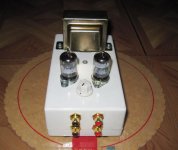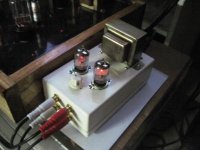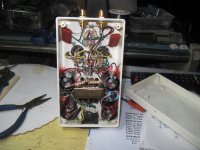where is it written that the 0 volt node of a supply must be grounded?
for me this, along with the common misnomer of calling this node ground is one of the fundamental reasons so many funky "loop" issues and noise problems are created because of this widespead belief.
for me this, along with the common misnomer of calling this node ground is one of the fundamental reasons so many funky "loop" issues and noise problems are created because of this widespead belief.
where is it written that the 0 volt node of a supply must be grounded?
That's right, the circuit's common doesn't necessarily have to be grounded.
If the proper name was used, this wouldn't be so confusing to so many.
Some of the confusion may lay in the fact that there can be multiple types of ground with differing purposes, such as safety and signal grounds. Safety ground has to do with power mains shock hazard protection, intended to provide a short circuit path (activating the enclosed device's mains protection breaker, removing the shock hazard) should a given device's enclosure become energized by the mains due to an internal fault. Signal ground can be designated as any point in a circuit. All other points in that circuit having a very low impedance path to that designated point are also considered signal ground. Those low impedance paths could be via D.C. or A.C. coupling.
There's nothing magical about signal ground, it's simply a convenient common reference point for analyzing voltages throughout the circuit. Circuit voltages can't be measured on their own, as a monopole, they have to be measured relative to some other point. That point we call signal ground. Signal ground is not some physically absolute 0 volt node, it's only a relative reference for every other voltage node in the circuit. We consider it to be at 0 volts only because we've designated it as the circuit's voltage reference point.
There's nothing magical about signal ground, it's simply a convenient common reference point for analyzing voltages throughout the circuit. Circuit voltages can't be measured on their own, as a monopole, they have to be measured relative to some other point. That point we call signal ground. Signal ground is not some physically absolute 0 volt node, it's only a relative reference for every other voltage node in the circuit. We consider it to be at 0 volts only because we've designated it as the circuit's voltage reference point.
Last edited:
where is it written that the 0 volt node of a supply must be grounded?
for me this, along with the common misnomer of calling this node ground is one of the fundamental reasons so many funky "loop" issues and noise problems are created because of this widespead belief.
I'd say the fundamental reason so many "funky loop issues and noise problems are created" is the mistaken belief that if two points are connected by a wire "they're the same voltage". As you say, it's often irrelevant whether "ground" is connected to earth or not, but the more subtle problem is it's often irrelevant that various points on that "ground" are even connected *to each other*, never mind earth.
Most ground wires, or ground connections, are not grounds at all.
They are the second wire/connection of a signal pair.
Every circuit connection needs two wires. The source supplies current and that current MUST RETURN to the source. This requires a Flow wire and a Return wire.
Each signal flow and return pair should be labeled with it's own name. No confusion.
I have been trying to get this point across for years, but the use of "ground" is so ingrained that hardly anyone wants to listen.
I have recommended a few times in this Forum that we stop using the word "ground" and use the unique name to label a wire/trace/node.
One of the biggest culprits is the mis-use of GND in the schematics. Here, all those that are new to electronics get "taught" that GND means all these nodes are the same and get connected as if they were the same and that circuit performance will be perfect if all these nodes are inter-connected in any haphazard arrangement. This mis-use is simply laziness. It is quick and easy. It is not accurate.
And there's the problem. The GNDs in the sch are not the same. They should never be haphazardly inter-connected.
Even the very experienced use GND in their schematics because it saves them time.
We should learn to stop this bad practice.
Make each circuit connection work correctly by connecting both the Flow and Return wire/trace.
They are the second wire/connection of a signal pair.
Every circuit connection needs two wires. The source supplies current and that current MUST RETURN to the source. This requires a Flow wire and a Return wire.
Each signal flow and return pair should be labeled with it's own name. No confusion.
I have been trying to get this point across for years, but the use of "ground" is so ingrained that hardly anyone wants to listen.
I have recommended a few times in this Forum that we stop using the word "ground" and use the unique name to label a wire/trace/node.
One of the biggest culprits is the mis-use of GND in the schematics. Here, all those that are new to electronics get "taught" that GND means all these nodes are the same and get connected as if they were the same and that circuit performance will be perfect if all these nodes are inter-connected in any haphazard arrangement. This mis-use is simply laziness. It is quick and easy. It is not accurate.
And there's the problem. The GNDs in the sch are not the same. They should never be haphazardly inter-connected.
Even the very experienced use GND in their schematics because it saves them time.
We should learn to stop this bad practice.
Make each circuit connection work correctly by connecting both the Flow and Return wire/trace.
Last edited:
bump
Its only 3 hours since the last reply. Have those responses not covered your enquiry ?
🙂
as this is such a common and widespread issue and with the volume of inquires about this and resultant problems i was hoping to create a greater awareness by keeping it an active topic, sorry!
You can do little better than see "ARTICLES" -
Audio Component Grounding and Interconnection
by David Davenport
Audio Component Grounding and Interconnection
by David Davenport
This requires a Flow wire and a Return wire.
During the positiv signal half cycle, the flow flows in the Flow wire but in the next half, the flow flows in the Return wire...
//
as this is such a common and widespread issue and with the volume of inquires about this and resultant problems i was hoping to create a greater awareness by keeping it an active topic, sorry!
you will know you have done it correctly by the amp you make.....
i made a common cathode line amp on a plastic enclosure
that is very quiet as quiet can be....
sure we can talk about it day in day out.....but you still have to make something....
Attachments
I've also learned to use Ground for when it's an internal ground. Nothing like Signal ground or reference ground as that can still have a different purpose. I just like to keep Ground for circuits inside a device, and "Earth" as a fault ground term.
I'm with Andrew, the word 'ground' adds nothing but confusion.
Some common use's of the word 'ground':
a] DC supply common
b] circuit common
c] chassis
d] AC supply Protective Earth/Safety Ground
e] Planet Earth
f] magic grounding box
But some real definitions are:
a] common reference point
b] equal-potential point (a point where, no matter how much voltage, no matter at what frequency and no matter how much current enters or leaves at point it stays at reference). These are hard to find in the real world.
Some common use's of the word 'ground':
a] DC supply common
b] circuit common
c] chassis
d] AC supply Protective Earth/Safety Ground
e] Planet Earth
f] magic grounding box
But some real definitions are:
a] common reference point
b] equal-potential point (a point where, no matter how much voltage, no matter at what frequency and no matter how much current enters or leaves at point it stays at reference). These are hard to find in the real world.
the original question was intented to illustrate the very point that not everything termed "ground" is the same, nor should they be connected together.
What about star-ground? Does this make things worse?
This is interesting, but can you illustrate where it's wrong?
When I say "you" I mean "anyone" who feels "ground" is labeled wrong?
Do you have an example circuit?
I've been building electronic boxes since 1987 and still find electronics very confusing.
I think this is due to improper labeling. You can picture concepts or you can't. I can't, mostly because I expect laws to apply. So, maybe if things were labeled properly, things would be more clear. I'm still waiting for that bell to go off in my head, but I don't think it will happen in my life-time.
V.
This is interesting, but can you illustrate where it's wrong?
When I say "you" I mean "anyone" who feels "ground" is labeled wrong?
Do you have an example circuit?
I've been building electronic boxes since 1987 and still find electronics very confusing.
I think this is due to improper labeling. You can picture concepts or you can't. I can't, mostly because I expect laws to apply. So, maybe if things were labeled properly, things would be more clear. I'm still waiting for that bell to go off in my head, but I don't think it will happen in my life-time.
V.
I think this is due to improper labeling.
'Reference node' is the clearest name for ground to me.
AJT, your caps are bleeding 🙂
ahhh, those are "rugby" rubber cement used to fix the caps in place.....
to me what matters most is the outcome.....
as shakespeare put it, "what's in a name? a rose by any other name smells as sweet..."
- Status
- Not open for further replies.
- Home
- Amplifiers
- Power Supplies
- when is ground not ground?


